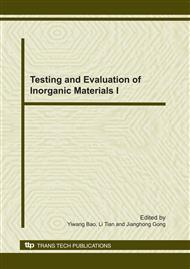p.566
p.570
p.574
p.578
p.584
p.590
p.594
p.598
p.602
Detecting the Efficiency of Cathodic Protection in Reinforced Concrete by Use of Galvanostatic Pulse Technique
Abstract:
The galvanostatic pulse technique has been applied in detecting the efficiency of cathodic protection in reinforced concrete based on the investigation on the response of galvanostatic pulse to the corrosion state of steel and perturbation magnitude of signal. Two data analysis methods were introduced to determine the corrosion rate. It is shown that the selection of perturbation magnitude of signal to be applied depends strongly on the corrosion state of steel. Too small current makes it difficult to separate the potential signal from background noise, whereas higher current results in intensive polarization. Thus, neither of two is beneficial for the data processing. The corrosion rate values obtained from chronopotentiometry method are on the low side during cathodic protection monitored by higher perturbation signal and correction of data employing polarization conversion method is suggested.
Info:
Periodical:
Pages:
584-589
Citation:
Online since:
December 2010
Price:
Сopyright:
© 2011 Trans Tech Publications Ltd. All Rights Reserved
Share:
Citation:


